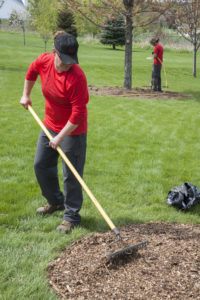Winter Protection of Trees and Shrubs

This time of year, many people wonder how they should be preparing their yards for winter. We suggest attending to new plantings, preparing evergreens, be aware of winter burn, and protect any trees, shrubs, or plants that might be subject to animal feasting.
New plantings are most susceptible to winter desiccation because they don’t have established root systems. Continue to water these new plantings through fall. Watering can be done until frost and is strongly encouraged for new plantings and evergreens. People often overlook the fact that trees and shrubs still transpire (although slowly) through winter. Roots still grow in unfrozen soil, so it is important to tend to them until frost takes over.
Evergreens have foliage to support and therefore are also very susceptible to winter burn. Damage is not directly caused by how cold it gets, but rather how quickly the cold comes. Rapid 40 degree swings from day to night can cause the most damage. Photosynthesis and respiration still take place in winter on sunny days through needles and bark, which requires soil moisture. When there is little snow cover, the soil freezes to deeper levels, limiting moisture uptake. Deep snow is more beneficial because it insulates the roots and provides moisture when it melts. Mulch helps insulate the roots as well. We recommend three inches of mulch around trees, but take care to keep the mulch away from the trunk itself. Little snow and excessive dry wind make for the harshest of winters for these trees.
Winter burn is the result of plants drying out over winter, but there are other types of damage. Growth that has not hardened off can easily be damaged by early frosts. Buds can be injured during late frosts, causing tattered looking leaves in the spring and early summer. De-icing salt can damage plants along sidewalks and roads. They can dry aerial parts of the plant in the winter, but cause continuing problems later. The residual salt in the soil concentrates when the water table drops during mid-summer droughts. If you know of an area in your yard that routinely gets a good amount of salt indirectly applied to it, a little extra watering in the spring will help. You may also want to consider applying some garden gypsum to help break it up.
As animals run out of easily accessible food, they may turn to your trees and shrubs. It is best to fence off areas to deter wildlife from browsing. Also, deep snowbanks can create the perfect cover for rodents to girdle stems. If you can help it, don’t pile up shoveled snow in one area.
We never really know what winter will have in store for us. These tips should give you some ideas of what you can do to prepare your yard for whatever might be coming.
~Melissa Veloon
